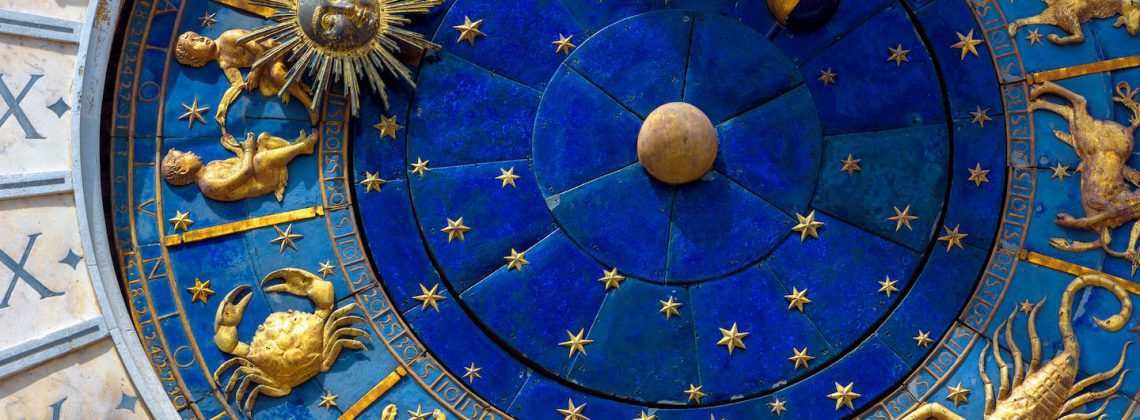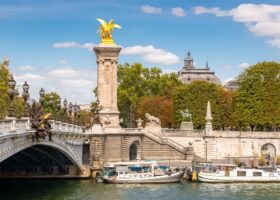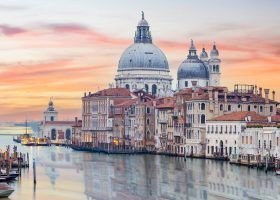Heading to Venice and don’t want to miss out on some of the coolest attractions in the city? Our local guides have compiled this list of the top things to see in Venice, so your experience of the Floating City will be a memorable exploration of Venetian history and culture. Thank us later!
Pro Tip: Planning what to eat on your trip to Venice? Bookmark this post in your browser so you can easily find it when you’re in the city. See our comprehensive guide to Venice for more planning resources, our top Venice tours for a memorable trip, and how to see Venice in a day.
The Top 16 Monuments and Attractions in Venice
Venice is undoubtedly one of the world’s most beautiful and unique cities. The Floating City has 400 bridges and 177 canals that connect the archipelago or cluster of 118 islands. It also has an incredible origin story.
After the fall of the Roman Empire, some Romans fled to the island(s) for protection and settled there. Romans were highly civilized and educated engineers so they got started on what you see today. And what exactly is that?
Something from a dream. Thousands of interconnected buildings with incredible architecture hovering over the water. Over time, the island began to thrive and evolve. Today, visitors flock to the city to experience its remarkable beauty and history. This list of the top things to see in Venice will help you appreciate the best of them.
We’ll start with the many wonders near St. Mark’s Square and move outward. However, if you’re looking for things that are not top tourist spots, scroll down to number six on this list and start there. Use the toggle menu below to discover more ways to explore Venice.
1. St Mark’s Square
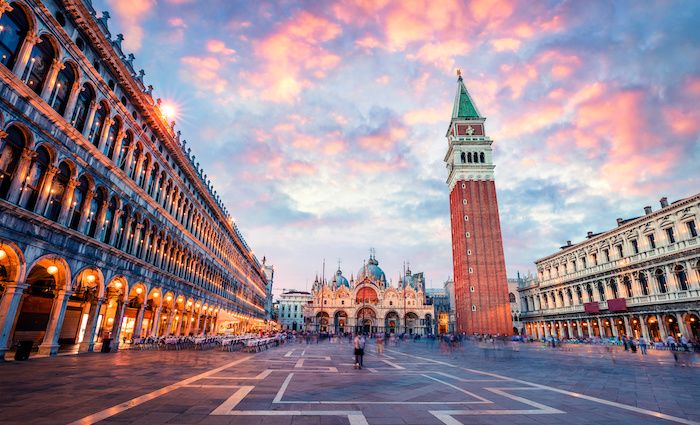
St Mark’s Square is named after the Basilica of St. Mark. The basilica is obviously named after the apostle, Mark, whose relics are contained inside. What you see today is nothing like what you would have seen in the 9th century when the area began to take form. This is definitely one of the top things to see in Venice.
There was an orchard occupying part of the space as well as a small canal running through it. Imagine a much more rural setting than the photo above. They erected the campanile or bell tower in the 10th century in some form, but we’ll get to that below.
It wasn’t until the 12th century that the square began to take shape. They filled the canal in and demolished some structures in the area to make way for the grand piazza.
The Procuratie on the left side of the photo was constructed in the 13th century and consisted of offices and residences for the procurators of the basilica. In the 18th century, the current flooring was laid in the piazza.
Address: Piazza San Marco
2. St Mark’s Bell Tower
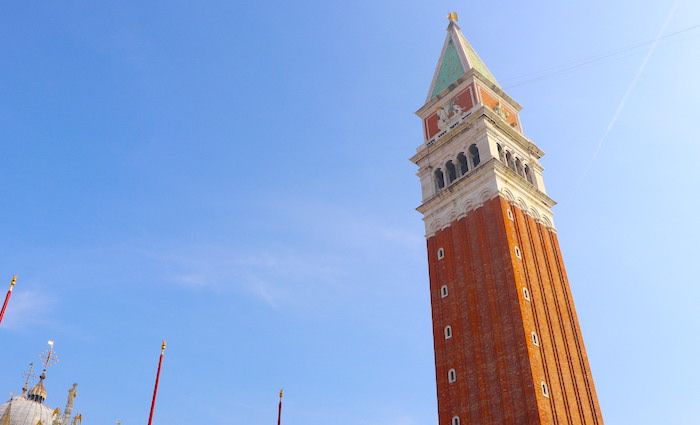
The Campanile of St. Mark, or bell tower, is a crowning jewel of St. Mark’s Square and the Venetian skyline. The descendants of the original Roman inhabitants constructed it. They built the structure for the same purpose it serves today: to have a great view.
However, having a great view served a much more important purpose in the 10th century. As you can imagine, a watchtower allowed residents to spot enemy ships from a distance and maintain the safety of the inhabitants. It is 323 feet tall (98.6 meters) making it the tallest structure in Venice.
The original bell tower collapsed in 902 just around its 1000-year birthday. As a result, they built this copy of the original you see today over a period of 10 years from 1902 to 1912.
In popular culture, the bell tower’s shadow, or ombra in Italian, is the term used to describe a glass of wine in Venice. This is because the fisherman would come back from fishing at midday and have a glass of wine in St. Mark’s Square. To stay out of the sun, they’d stand in the ever-moving shadow of the bell tower cast across the piazza.
Address: Piazza San Marco
Popular Venice Tours
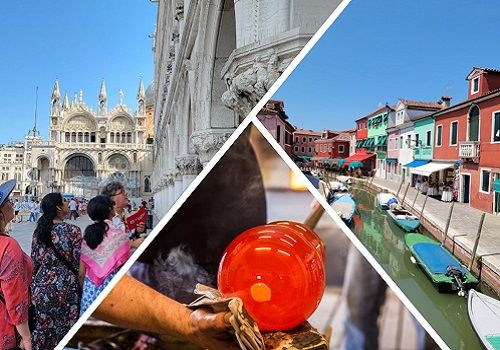
Best Selling Tour
Ultimate Venice in a Day with Murano and Burano
The ultimate tour of Venice. You’ll get skip-the-line access to the most important buildings in Venice, plus a gondola ride, and private transportation to the islands of Murano and Burano. It’s a full day of touring that will make for the best memories in Venice ever.
See Prices
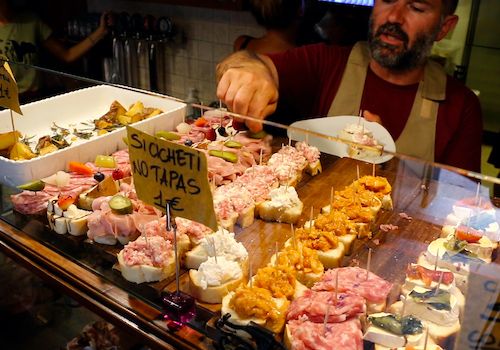
Authentic Experience
Venice Evening Food Tour in Cannaregio District
People who say Venice is too touristy have not done enough research. Cannaregio is an amazing break from the crowds, and our food tour is the most authentic way to experience it. Taste cicchetti and other Venetian specialties including wine. You’ll leave with a full stomach and a love for Venetian food!
See Prices
Not ready to book a tour? Check out our article on the best Venice tours to take and why.
3. St. Mark’s Basilica
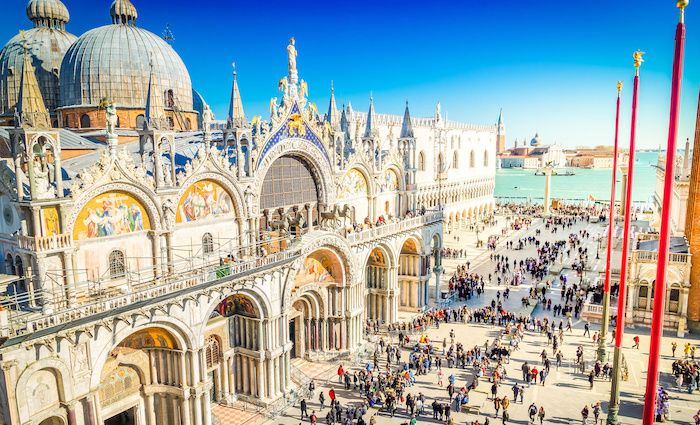
In The Beginning
The Basilica di San Marco or St. Mark’s Basilica is the main cathedral in Venice dedicated to the city’s patron saint, St. Mark. One of the apostles, St. Mark is a pretty big deal in the Catholic church and Christianity as a whole.
What you see today, shown in the picture above, has been a work in progress over the last 1,100 years or so. The original church that stood there was similar in layout but the design and ornamentation have evolved greatly.
Did you know the St. Mark’s Basilica wasn’t built to preserve the holy ruins of the saint, but was the private chapel of the Doge during the Venice Republic? Its original name was “Basilica d’Oro”, or Golden Basilica, because of the over one thousand square meters of golden mosaic tiles.
In A.D. 828, the Doge Giustiniano Partecipazio expanded the chapel and linked it to the existing church when St. Mark’s body arrived in Venice from Alexandria, replacing the city’s protector St. Theodore. From that moment, a winged lion, St. Mark’s crest, became the official symbol of the Venice Republic.
Originally, the patron saint of Venice was St. Theodore, a Greek saint. The original structure was built around 819 and was likely constructed primarily from wood. About 10 years later, the relics of St. Mark were stolen from Alexandria in Egypt.
Having the relics of an apostle would have been a massive draw to the city of Venice, so the current Doge decided to change the patron saint of Venice to St. Mark. Parts of the structure you see today would have been started around the end of the 11th century.
The Middle Ages
After years of work, they completed the basilica in 1071, finally consecrating it in 1094. In 1145, a deadly fire destroyed a huge part of the upper decorations inside of the basilica.
To prevent this from happening again, it was then covered by the marble you can admire today. A bit later, in 1159, precious mosaic decorations were added to the walls and ceilings of St. Mark’s Basilica, replacing the old frescoes.
The Fourth Crusade And Today
In 1204, after the Fourth Crusade, Venetian crusaders brought precious marble and works of art back to Venice from their conquest of Constantinople. This includes the iconic four-horse chariot in bronze, the icon of the Madonna Nicopeia, enamels of the Golden Altarpiece, relics, crosses, and chalices.
The names of the architects and artists who contributed are unknown, but the predominant style is Greek-Byzantine with strong German and Arabic influences. The church served as the Doge’s chapel until 1807 when Napoleon turned it into a public basilica.
One of the first things you’ll notice is the difference between this basilica and others in Italy. You should know that Venice is very different from Italy in that the city tends to skew more eastern European—they are right on the border. Many things are unique to the city and others are influenced by the East. The Basilica of St. Mark has a strong resemblance to the Hagia Sofia of Byzantium.
Never heard of Byzantium? How about Constantinople? Ok, one more try, Istanbul? Venice was part of the Byzantine Empire until they broke away in 1171. The church is extremely ancient. Much of the construction took place between the 11th and 13th centuries.
Frescoes have been updated, more gold has been added, and statues built in, but you are definitely looking at one of the older churches on Earth. Find out how to visit St. Mark’s Basilica.
Address: Piazza San Marco
Not ready to book a tour? Check out our St. Mark’s Basilica Guide for more resources.
4. Doge’s Palace
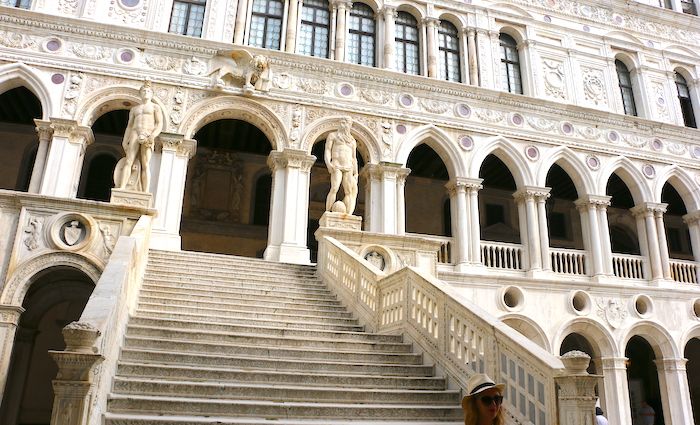
The Venetians decided to build the Ducal Palace around the 9th century, however, no remains of the 9th-century building remain today. After 1296, more people had the right to take part in legislative assembly meetings. So, they needed to enlarge the government areas.
The result of those works is the beginning of the building that we see today. The work started around 1340 under Doge Bartolomeo Gradenigo (1339-1343) and mostly included the side of the palace facing the lagoon.
Guariento, the Paduan artist, decorated the east wall of the Great Council Chamber with a large fresco in 1365. Similarly, the Delle Masegne family decorated the windows. In 1419, the Great Council met in this chamber for the first time.
In 1424, renovation works continued on the side of the building that faces St. Mark’s Square. They designed a new wing that went hand in hand with the design that overlooked the lagoon.
Fire of 1483, 1574, and 1577
A raging fire destroyed the canal side of the palace, which included the Doge’s apartments in 1483. At this time, Antonio Rizzo introduced the new Renaissance style to the building. They finished the works in 1510 and replaced Rizzo with Maestro Pietro Lombardo. The new architect began the design of the facade and the Giant’s Staircase in the internal courtyard.
Giants Staircase
During this period, Sansovino created two large marble statues of Mars and Neptune at the top of the Giant’s Staircase. Despite another fire breaking out in 1574, it didn’t cause any serious damage, with the exception of the wood furnishings.
It’s hard to believe but in 1577, another fire damaged the Sala dello Scrutinio and the Grand Council Chamber, destroying masterpieces by Gentile da Fabriano, Pisanello, Alvise Vivarini, Carpaccio, Bellini, Pordenone, and Titian. By 1580, they had restored the area to its original state.
Napoleon
The Venetian Republic fell in 1797 first to the French, then to Austria, and finally became part of a unified Italy in 1866. The palace had been the heart of political and public administration during its independence, but it ceased to hold those functions once occupied and lost relevance.
The Museum Today
In a state of disrepair, major renovation works began at the end of the 19th century to spruce it up. Many of the original 14th-century capitals were relocated to the Museo dell’ Opera for safekeeping.
All the public offices were moved elsewhere except the State Office for the Protection of Historical Monuments, which is still housed here. It became a museum in 1923 and, in 1996, became a part of the Civic Museums of Venice network. Find out how to visit the Doge’s Palace.
Address: Piazza San Marco, 1
Not ready to book a tour? Check out our Doge’s Palace Guide for more resources.
5. St. Mark’s Clock Tower
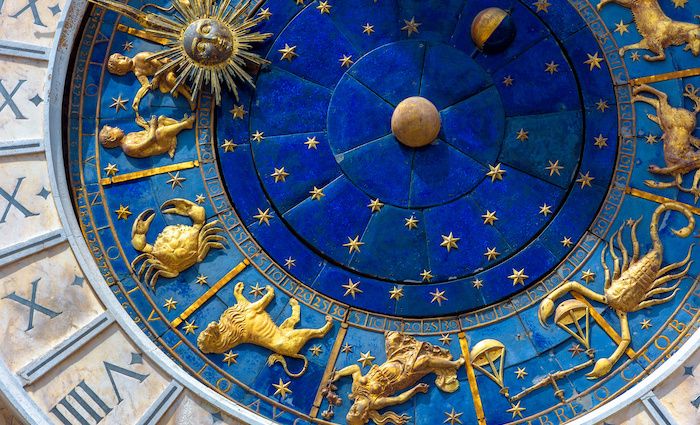
TheTorre dell’Orologio, or Clock Tower, is the simple name for this ornate attraction. A clock tower, similar to fountains, is a feature we can’t fully appreciate today. Not because of millennials, but because of the technology we have on our wrists and in our pockets.
In the 16th century, people didn’t have cell phones, wristwatches, or probably even a clock in their homes. If it wasn’t for communal clocks, they simply wouldn’t know what time it was. This would have been very important for a commercial hub like Venice, hence St. Mark’s Clocktower.
If you’re standing in Piazza San Marco, you can’t miss the tower to the left of St. Mark’s Basilica. On top, there are two moors that ring the bell each hour. You’ll also see the Lion of St. Mark on a blue and gold starred background. The lion is the symbol of Venice. There’s also an analog feature showing the hour and minutes on either side of a statue of the Virgin Mary with baby Jesus. See if you can spot it!
If you’re lucky, you may see the clock in its entirety. It only happens twice a year, but the three Magi will emerge from the clock following Jesus the child. This happens on January 6th, Epiphany Day, which is the day the three magi visited Jesus who would become God incarnate. The second time is 40 days after Easter, which is the day Mary ascended to heaven. It lands on a Thursday and you are supposed to include Easter into the calculation.
Address: Piazza San Marco
6. Bridge of Sighs
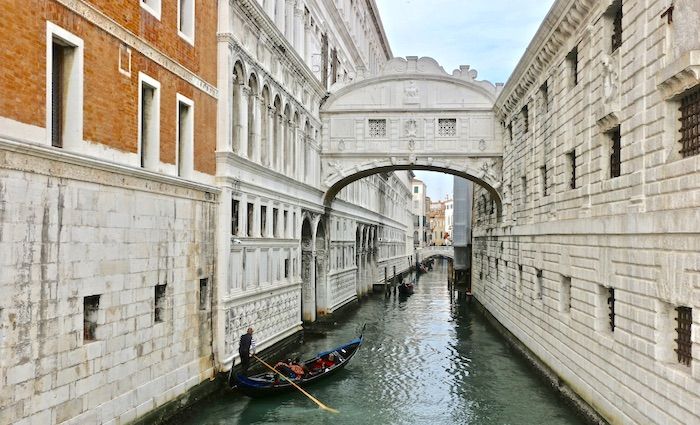
The Ponte dei Sospiri, or Bridge of Sighs, is one of the more poetic names you’ll hear for a bridge and it preserves its history. The bridge connects the prison, Prigioni Nuove, and the interrogation rooms at the Doge’s Palace. Needless to say, the people taken over this bridge had plenty to sigh about.
Interestingly, the bridge was built by Antonio Contino—the nephew of Antonio da Ponte. Da Ponte, whose last name literally translates to “of the Bridge”, designed the Rialto bridge.
I doubt he was born with that name, but if he was, it was fate that he re-build what is one of the most famous bridges on Earth—the Rialto. You can best see the Bridge of Sighs from inside the Doge’s Palace or outside by heading to Ponte della Paglia.
Address: Piazza San Marco
7. Giant Hands (Now Closed)
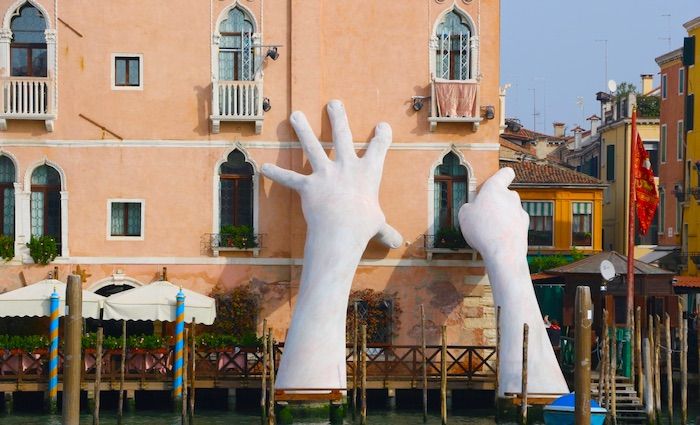
This incredibly cool and eye-catching art installation is known simply as “Support,” but most people refer to it as giant hands. What is it? Other than massive hands protruding from the Grand Canal, it’s a call to action over climate change, which threatens Venice.
The artist behind these hands is Lorenzo Quinn and you can find them “holding up” the walls of the Ca’Sagredo Hotel right on the Grand Canal. The sea surrounding Venice has been rising significantly and will continue to do so over the next 100 years, making the city even more difficult to inhabit. The hands were in Venice until 2017 when they were removed. Now we only have photos!
Unforgettable Venice Tours
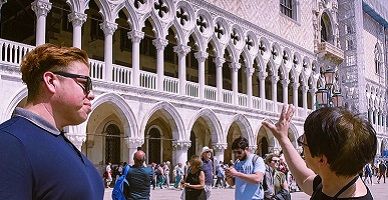
Best Selling Tour
St. Mark’s Basilica & Doge’s Palace Half-Day Tour with Gondola Ride
Get to know the best of Venice’s main attractions at St. Mark’s Square in just a few hours. You’ll have skip-the-line access at St. Mark’s Basilica. Then, head underground to the dungeons at the Doge’s Palace and cross the Bridge of Sighs.
See Prices
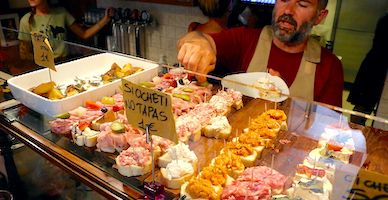
Authentic Experience
Venice Locals Evening Food Tour in Cannaregio
People who say Venice is too touristy have not done enough research. Cannaregio is an amazing break from the crowds, and our food tour is the most authentic way to experience it. Taste cicchetti and other Venetian specialties including wine. You’ll leave with a full stomach and a love for Venetian food!
See Prices
Not ready to book a tour? Check out our article on the best Venice tours to take and why.
8. Fondaco dei Tedeschi
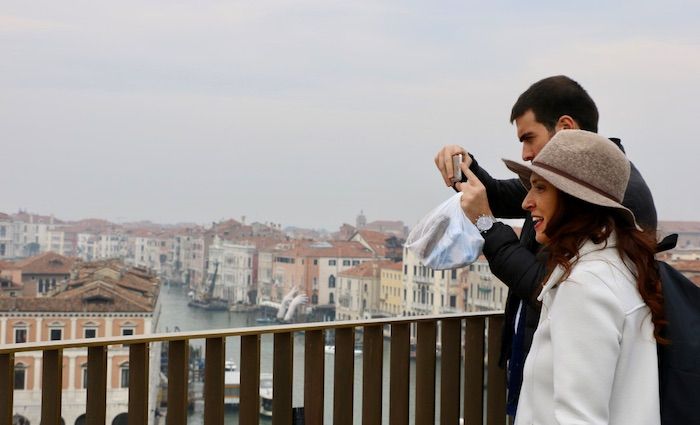
What’s better than a shopping mall with rooftop views in an ornate 800-year-old building? The modern structure is a shopping mall with lots of luxury goods as well as fantastic dining.
The crowning jewel is its rooftop terrace view, which you must book in advance to enjoy. Don’t worry, the rooftop is free, but they do limit visitors to avoid overcrowding.
History
Many take for granted just how old Venice is. Compared to many other European cities, Venice relies on very old structures as it is very difficult to bring in materials and build new structures. This is why you often see palaces, museums, and buildings built in the 13th and 14th centuries—a period when Venice was accruing power.
Fondaco dei Tedeschi sits right on the Grand Canal and is a shopping mall today. They restored it beautifully with many modern finishings blended with its ancient structure. The name, Fondaco dei Tedeschi, translates to “the Inn of Germans.” It was very popular for German merchants to travel to Venice, which was a wealthy merchant city that practically owned the spice trade.
Apparently, the structure was reserved only for Germans. This may have been from long-seeded mistrust due to the never-ending conflict between Romans and Germans, who did cause the fall of the Roman Empire.
Address: Calle del Fontego dei Tedeschi
9. Nino & Friends
If you have a sweet tooth, this is for you. Nino & Friends is without a doubt my favorite producer of sweets in the world. People come here for their chocolate, but there’s more—their store feels like Disneyland and their cookies are delicious. Not originally from Venice, the group is from Naples and has stores all over Italy. My wife and kids go nuts for their cappuccino cookies.
Address: Salizada S. Lio 5576
10. Fondamenta Misericordia and Cannaregio
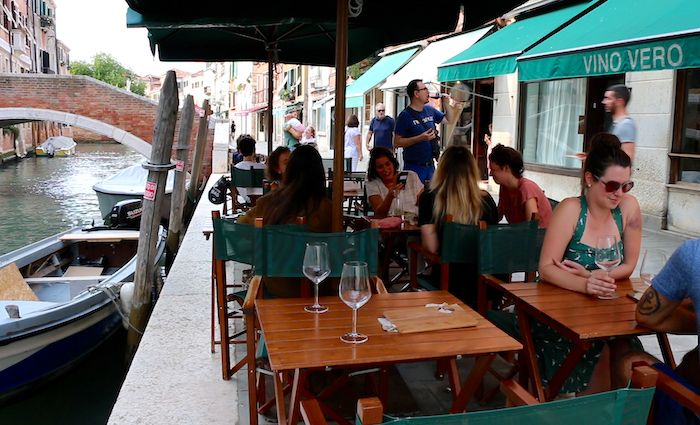
Visitors (and I) have declared Cannaregio Venice’s foodie district. Much like Trastevere in Rome and Santo Spirito in Florence, Cannaregio currently holds the Venice crown. Fondamenta Misericordia is the main drag in this area and it is lined with bars, restaurants, and cool places to eat and drink. Some great choices include Vino Vero, a canal-front wine bar in the featured image; Al Timon, known for its great food and atmosphere; and A La Vecia Papussa, a great place for cicchetti where many visitors eat more than once.
Check out our article on the best restaurants and bars in Cannaregio for more options. While in the area, also check out the Campo del Ghetto Nuovo. It’s a very local piazza/square to walk through full of locals. It’s in the opening scene of a video I filmed all about Cannaregio.
Address: Fondamenta de la Misericordia
Not ready to book a tour? Check out our Venice Guide for more resources.
11. Colored Houses of Burano Island
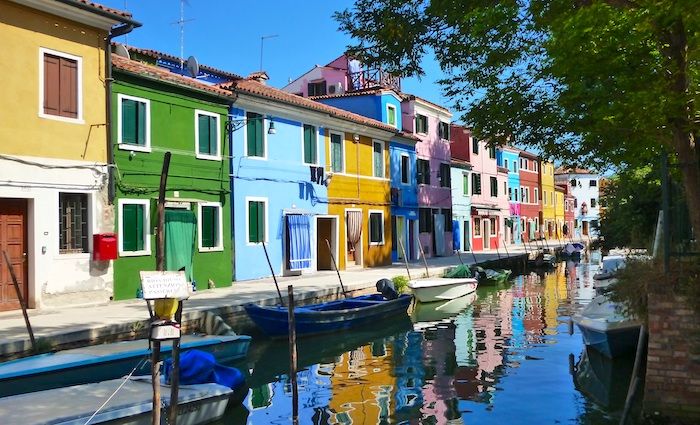
There are four things you need to know about Burano: Lace, risotto de gò, a leaning bell tower, and really colorful houses. First, let’s talk about lace. Burano, like many fishing villages, was pretty poor. You could pick one of two jobs: farmer or fisherman. At some point, lace was introduced to the scene and brought in a new revenue stream, which lifted the area economically.
Risotto de gò is basically a risotto dish made with a local fish called gò or goby fish in English. If you go to a buranella, which is a typical tavern-style restaurant on the island, you will almost definitely find it on the menu.
Next, you have the leaning bell tower, or Il Campanile Storto in Italian. The Italian name means “crooked,” which sounds pretty quirky, but Venetians are known for a strange sense of humor. Regardless, this leaning bell tower will leave you wondering so many things like, “will it fall down?”
That said, it’s not the only leaning tower in Venice. I’m sure you’ve heard of the Leaning Tower of Pisa, but there are two more in Venice: the Santo Stefano Bell Tower and the San Giorgio dei Greci Bell Tower. That may seem like a lot, but let’s say they weren’t exactly building on solid ground.
Burano is often recognized as one of the most colorful cities on Earth due to the brightly colored houses all over the city. Why? My favorite legend explains how fisherman painted their houses bright colors to be able to see them from far away on foggy days.
There is also a theory that the different colors allowed them to clearly differentiate where one house ends and the next begins. Regardless, it is a beautiful scene and one of the reasons why Burano is popular with artists.
Location: Burano Island
12. Murano Glass Blowing Island
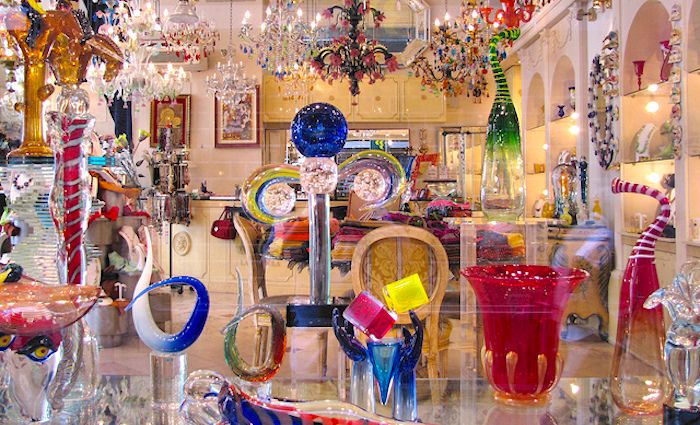
Murano is another island in the Venetian Lagoon that is not within the cluster of islands we know as “Venice” but is part of the city geographically. Like Burano, it has a small population of 5,000 people that mostly work in the town’s main industry: glass blowing.
Blowing glass became a top industry in Venice until city officials ordered glassmakers to move their furnaces off the main island in 1291. They feared the furnaces would start fires that could quickly spread on the main cluster of islands in Venice. The glassmakers complied and thrived in Murano. Like Silicon Valley, Murano became the epicenter for glass and the Kingdom of Venice enjoyed collecting taxes on the trade.
The Doge declared that the glassblowers could never leave Venice, so they could keep the industry internal and control prices. During their captivity in Venice, the glassmakers enjoyed privileged lives of great wealth and status completely above the law.
Today, the secret is out, but Murano still produces some of the highest-quality glass on Earth and even has a sacred stamp to prove pieces were made on the island. This all comes with a price tag, but, similar to purchasing gold on Ponte Vecchio, it’s part of the experience!
Location: Murano Island
Not ready to book a tour? Find out the best ways to visit Murano and Burano.
13. Rialto Bridge
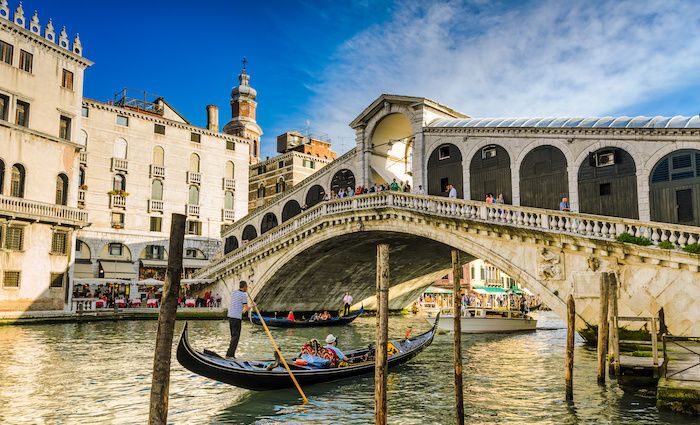
The Rialto Bridge is a decorative bridge crossing the Grand Canal in Venice. It is easily one of the top tourist spots in Venice and also one of the oldest.
The original bridge was a floating pontoon bridge built in 1181. In 1255, they replaced it with a wooden bridge that surprisingly lasted quite a while considering the humidity of the area.
It partially burnt down in 1310 and eventually collapsed due to weight in 1444 and again in 1524. The idea of building it out of stone came up in the 16th century and many great artists were considered including Michelangelo.
In the end, they chose a local, Antonio da Ponte, to build the bridge. Construction began in 1588 and finished in 1591, resulting in the structure you see today. Antonio’s last name translates to “of the bridge,” which is a bit ironic. I have researched it and can’t figure out if he changed his name to this later in life or if it was his birth name. Either way, it’s pretty fitting!
Address: Rialto Bridge
14. Rialto Market Area
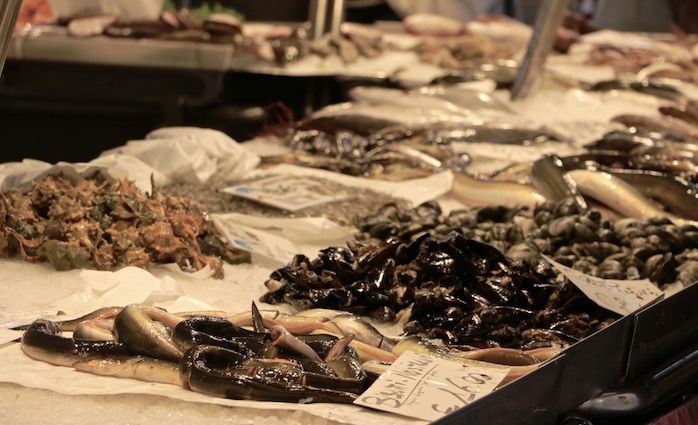
Rialto Market is where fish is brought in and sold each day. While it is not the ideal odor for a vacation, it is pretty cool to see the market in action. To see these transactions you have to wake up early and head over there, but it’s worth it.
The general area is really neat with great outdoor seating at all the restaurants. There is also a fruit market nearby, which is worth passing through.
Address: Campiello de la Pescaria 30122
15. Teatro La Fenice
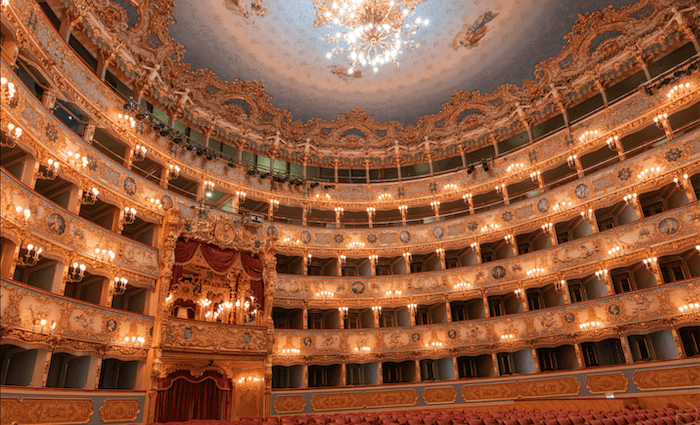
Teatro La Fenice is one of the most beautiful opera houses in the world with one of the most troubled histories you could imagine. According to the opera house itself, it was first built in the late 18th century but burnt down in 1771.
They rebuilt it but, apparently, it was partly on the land of the Venier family who did not appreciate the theatre. The owners had to sell it and then built a new opera house that they named Le Fenice, which means “the pheonix.” The name obviously points to the story of the phoenix rising from its ashes. The theatre would definitely put that name to the test.
They completed it in 1792 and opened with the symphony “I Giochi d’ Agrigento” by Giovanni Paisiello, which brought fame to the house. In 1836, the opera house burnt down for the second time. After two fires and one lawsuit, they decided to rebuild the house for the third time. They opened for the third time in 1837 and described it as even more beautiful than before.
Famous composer Verdi did sort of a “residence” there for some time between 1844 and 1857, composing five operas. Many famous composers would follow including Rienzi, Richard Wagner, Stravinskij, and music by the famed Pavarotti.
It is easily one of the most ornate opera houses on Earth and a treat to visit. You can view their lineup for a fancy night out online at Le Fenice Opera Schedule.
Address: Campo S. Fantin 1965
Popular Venice Tours
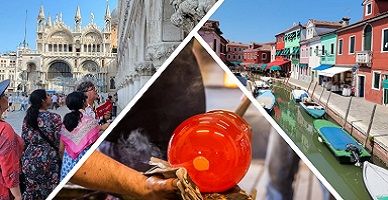
Best-Selling Tour
Ultimate Venice in a Day with Murano and Burano
The ultimate tour of Venice. You’ll get skip-the-line access to the most important buildings in Venice, plus a gondola ride, and private transportation to the islands of Murano and Burano. It’s a full day of touring that will make for the best memories in Venice ever.
See Prices
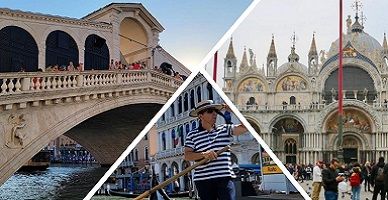
Top-Rated Tour
Venice in a Day Combo Tour with Gondola Ride
Only have a day in Venice and want to explore the best places? You’ll love this tour that includes skip-the-line access to St. Mark’s Basilica and the Doge’s Palace so you don’t waste time! Not to mention, you’ll wander through the Cannaregio district and learn about Rialto Bridge before floating through the canals on your own gondola.
See Prices
Not ready to book a tour? Check out our article on the best Venice tours to take and why.
16. Libreria di Acqua Alta

The name translates to the “Library of High Water” and they’ve been internet famous for years. This little bookstore attracts visitors like St Mark’s Square due to a creative way to protect themselves from flooding. Basically, all their books are situated far above ground level, which is pretty normal, but all inside waterproof containers.
If you’re thinking “container store,” think again. They went more Venetian and have a full-sized gondola with books inside that you can choose from. They pack their store with interesting reads and titles from all over the world. Out back, pictured above, you’ll find a staircase made out of books that allows you to see into the canal behind the store.
Despite the quirkiness, they have cool vintage books and it’s probably the most beautiful bookstore on the planet, as they say. I’ve purchased old Italian children’s books for my kids here as well as postcards and other fun stuff.
Address: Calle Lunga Santa Maria Formosa 5176b
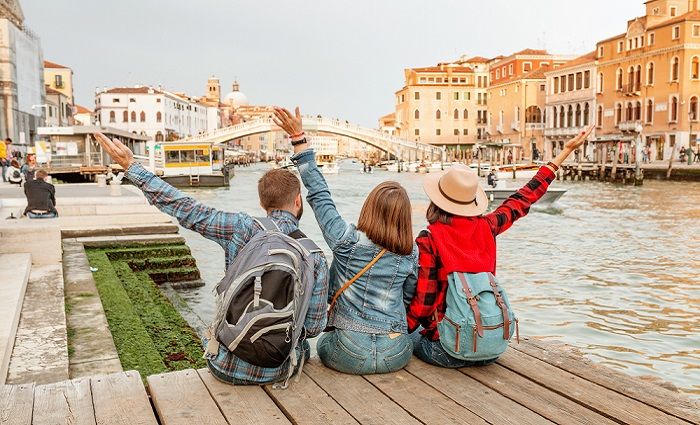
Where To Stay in Venice
Despite the size of this little island, there are endless hotel options to choose from. We’ve picked the best neighborhoods and hotels to stay in whether you prefer Italian luxury or quiet serenity—or both!
